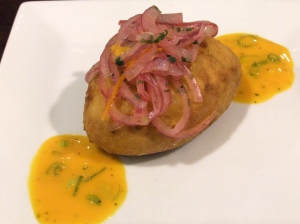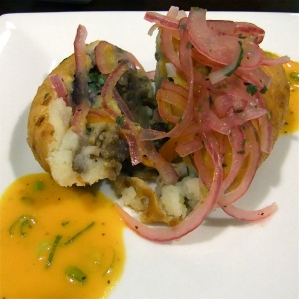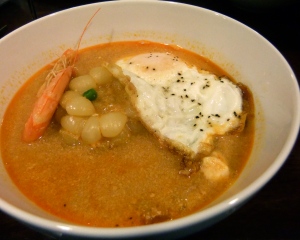This is bad, and I mean real bad. Because it is too good—too good for New Year resolutions, too good to for a nondescript name like “Grandma’s Pie” and seriously too good to resist.
My 2011 began with such promise. After proclaiming it The Year of the rabbit Me, I made goals like “no more yogurt and cereal for dinner”, “cut back on sugar” and “say ‘yes’ to people and activities that make me happy and ‘no’ to those that don’t. I am proud to say that breakfast for dinner is no longer a part of my daily life; I also started learning Japanese taiko drumming (this city is seriously the best; you can do/find everything here), I’m joining a choir again, I’m volunteering more in the arts, and I even left the city last weekend to visit a friend. Yes, I crossed to the other side of the bay (very Sex & The City girls go to the Hamptons—too funny since I’m not sure East Bay really counts as a weekend retreat.) Anyway, that’s all good stuff. But sugar. Sugar, sugar, sugar. No gold star for me there.
I knew what I was doing when I made the ricotta cheese; it was for this tart. Very bad. I also knew what I was doing when the next evening I decided to make oatmeal raisin cookies with coconut and walnuts. Again, very bad. (Recipe to follow shortly, of course). I’ve resolved to be better. Starting this week. After my cookie post I have a healthy oven-braised chicken recipe to share.
Now to the tart. It’s another recipe from someone’s grandma, so you know it’s been tried and tested by an Italian grandma somewhere. The pastry recipe I got from Mario Batali via the Food Network, though I’m not sure it’s really from his Nonna. And the filling recipe I took from Cook Almost Anything, and apparently, it’s from her mother. Regardless of origin, both are fantastic.
I went with Mario’s pastry recipe as it required way less fat (as in 3 tbsp each butter and olive oil vs almost 1 cup butter). It was simple to put together and when finished reminded me of pasta dough. As for the filling, I particularly liked the addition of semolina and lemon zest. I added raisins to the mix and the additional handful almonds for topping, but otherwise left the recipe alone. Assembly and baking are pretty standard. The tart will rise a bit while in the oven, especially in my case since my dough was still a bit raw after 35 minutes and I had to bake for an additional 10. One thing worth noting about the dough is that it is not supposed to be too golden, so don’t keep the pie in for too long waiting for the right color because you’ll just over-bake it and end up with a dry custard. In hindsight, I probably should have baked for only an extra 5 minutes as I think my custard would have been a smidgen creamier. Oh well, next time. Overall, though, I’m happy with my efforts! And by the way. I baked it Thursday, and it was gone Sunday night. (And yes, I did share 😛 )
Enjoy!
Torta della Nonna
INGREDIENTS
Pastry (adapted from Mario Batali recipe via Food Network)
2 cups all purpose flour
1 large egg plus 2 egg yolks
1/2 cup sugar
3 tbsp sweet butter plus 3 tbsp extra virgin olive oil, melted together
1/2 tsp vanilla extract
Filling (adapted from Cook Almost Anything)
1 1/4 cup whole milk
scant 1/2 cup semolina
1 lemon, zested and juiced
1 1/4 cups whole milk ricotta cheese
2 large eggs
1/2 cup sugar
1/2 cup raisins, optional
handful almond flakes, optional
confectioner’s sugar, optional
METHOD
- Preheat the oven to 350 F.
For the pastry
- To make the pastry, make a well in the flour, and place egg, yolks, sugar, butter and olive oil mixture in the center and proceed as you would with fresh pasta, i.e. bring flour in bit by bit until the liquid in the well is thick enough to bring together with your hand. Knead until the dough is smooth, then allow to rest 10 minutes.
For the Filling
- Heat the milk in a saucepan until just warm – rain in the semolina, stirring as you do to stop any lumps forming. Add the lemon zest and continue to stir until the mixture thickens and comes away from the side of the pan. Take it off the heat to cool.
- Push the ricotta through a fine sieve – this just helps to lighten the mixture. (Skipped this step…no fine sieve.) Place the sieved ricotta into a large bowl, add the eggs, sugar, lemon juice and cooled semolina mixture and using an electric mixer, beat until thoroughly mixed. If using, stir in the raisins now.
- Prepare the pastry case: Divide the dough into two—two-thirds for the base and one-third to form the top.
- On a well-floured surface, roll the larger piece out to line the base and sides of a loose-bottomed 20 cm/8 inch round pie pan. Make sure the pastry overhangs the lip to make joining the top easier.
- Pour the prepared filling into the case, smoothing it out to level the surface. It will rise when it cooks so don’t worry if it doesn’t reach the top of your pie case.
- Roll the smaller piece of pastry to form a circle a little larger than the pie pan.
- Brush the lip with a little milk before placing the pastry top – press down to make sure the dough sticks and then trim to size.
- Lightly brush the top with the milk, a sprinkle of sugar and, if using, a handful of almonds.
- Bake in a preheated 350 F for 30-35 minutes or until the pastry is golden and cooked through. (Mine needed 45 because after 35 the dough was still raw. To prevent burning, I covered the pie with a piece of foil with the center cut out.)
- Remove from the oven and let it cool for 5 minutes in the pan before removing it to a wire rack. At this point, you could dust the top generously with confectioner’s sugar. (I chose not to.)





























